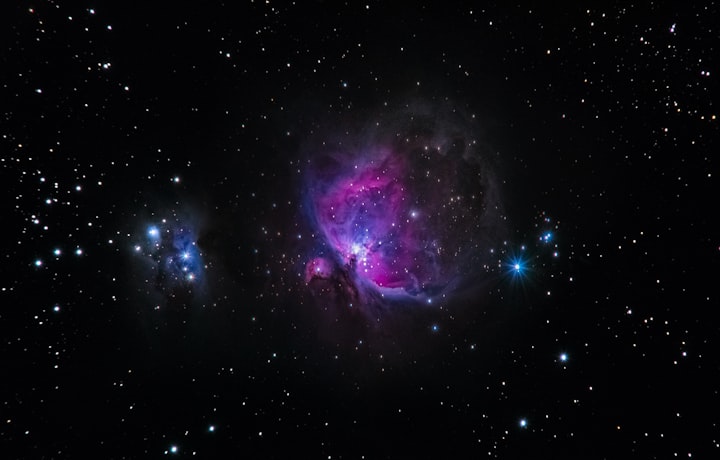Galaxy Formation Theories
All u want to know about galaxy

Galaxies are the building blocks of the universe, and they come in a wide range of shapes, sizes, and types. From spiral galaxies like our Milky Way to elliptical galaxies, irregular galaxies, and even dwarf galaxies, these cosmic structures play a vital role in our understanding of the universe's origins and evolution. But how do galaxies form, and what processes shape their structure and behavior over time? In this article, we will explore the fascinating world of galaxy formation and uncover some of the mysteries that still remain.
The Big Bang and the Early Universe
After the Big Bang. About 13.8 billion years ago, the universe was hot, dense, and filled with radiation. As the universe cooled down, subatomic particles started to form, and eventually, the first atoms were born. This period, which occurred about 380,000 years after the Big Bang, is known as the Cosmic Microwave Background (CMB) era.
Over time, gravity began to take hold, and small perturbations in the density of matter started to form. These perturbations eventually grew in size and became the seeds for the formation of galaxies. The precise details of how these perturbations grew into galaxies are still being studied, but we have some ideas based on observations and simulations.
Theories of Galaxy Formation
There are two main theories of galaxy, the top-down theory and the bottom-up theory. The top-down theory suggests that galaxies formed first, and then stars and planets formed from the material in the galaxies. The bottom-up theory, on the other hand, proposes that small clumps of matter formed first, and then these clumps merged over time to form galaxies.
The bottom-up theory, also known as the hierarchical model, is currently the more widely accepted theory of galaxy formation. According to this model, small clumps of gas and dust called protogalaxies formed in the early universe. These protogalaxies were the building blocks for larger galaxies and eventually merged together to form the galaxies we see today.
Simulations of galaxy formation based on the hierarchical model have been successful in reproducing many of the observed properties of galaxies, such as their size, shape, and distribution. However, there are still many open questions about the details of how galaxies form and evolve, and ongoing research continues to shed light on these mysteries.
Dark Matter and Galaxy Formation
One of the key players in the formation of galaxies is dark matter, a mysterious substance that makes up about 85% of the matter in the universe. Dark matter does not interact with light or other forms of electromagnetic radiation, making it invisible to telescopes and other instruments.
Despite its elusive nature, dark matter is believed to play a crucial role in galaxy formation. According to the current understanding of the universe, dark matter forms the scaffolding upon which galaxies form. The gravitational pull of dark matter helps to bring gas and dust together, leading to the formation of protogalaxies.
In addition to providing the gravitational pull needed to form galaxies, dark matter may also help to regulate the size and shape of galaxies. The distribution of dark matter in a galaxy's halo can affect how stars and gas are distributed within the galaxy, influencing its overall shape and structure.
Star Formation in Galaxies
Once a protogalaxy has formed, the next step is for stars to form within it. Stars are born from clouds of gas and dust that are compressed by gravity until they become hot enough to ignite nuclear fusion reactions in their cores. The exact process of star formation is still not fully understood, but we know that it requires certain conditions, such as a dense cloud of gas and a trigger to initiate the collapse.
In galaxies, stars form in regions of high gas density, such as spiral arms or in the centers of galaxies. These regions are often called "stellar nurseries" because they are where new stars are born. As gas and dust in the protogalaxy begin to collapse under their own gravity, they form clumps that eventually become hot enough to ignite fusion reactions, and a new star is born.
The rate of star formation in a galaxy is influenced by many factors, including the density of gas, the temperature, and the presence of other stars. In some galaxies, star formation is very active, while in others, it is relatively quiescent. The rate of star formation can also change over time as a galaxy evolves.
Galaxy Types and Evolution
Galaxies come in a wide range of shapes and sizes, from small dwarf galaxies to massive elliptical galaxies. The classification of galaxies is based on their shape, which is influenced by the distribution of stars, gas, and dust within them.
Spiral galaxies, like our Milky Way, have a disk-like structure with a central bulge and spiral arms that extend outward from the center. Elliptical galaxies, on the other hand, are more spherical in shape and have a smooth distribution of stars. Irregular galaxies have a more chaotic structure and often show signs of recent star formation.
The shape of a galaxy is thought to be influenced by many factors, including the distribution of dark matter, the rate of star formation, and the presence of other galaxies nearby. As galaxies evolve over time, their shape and structure can change as a result of interactions with other galaxies or changes in their environment.
Galaxies can also go through phases of intense star formation, known as "starburst" galaxies, where new stars are forming at a much higher rate than usual. These phases of intense star formation can be triggered by interactions with other galaxies or by changes in the galaxy's environment.
Supermassive Black Holes in Galaxies
In addition to stars, gas, and dust, galaxies also contain supermassive black holes at their centers. These black holes are millions or even billions of times more massive than the sun and have a profound influence on the surrounding galaxy.
Supermassive black holes are thought to form through the accretion of gas and dust, which falls into a disk around the black hole and gradually spirals inward. As the black hole grows, it emits powerful jets of radiation and particles that can have a significant impact on the surrounding galaxy.
The presence of a supermassive black hole at the center of a galaxy can influence its evolution in several ways. The gravitational pull of the black hole can influence the distribution of stars and gas in the galaxy, and the energy released by the black hole can affect the rate of star formation.
The Future of Galaxy Formation Research
Our understanding of galaxy formation has come a long way in recent decades, but there is still much to learn. Ongoing research, both observational and theoretical, continues to shed light on the complex processes that govern how galaxies form and evolve over time.
New telescopes and instruments, such as the James Webb Space Telescope and the Large Synoptic Survey Telescope, are set to revolutionize our understanding of the universe and help us unlock some of the mysteries of galaxy formation. In the coming years and decades, we can expect to learn much more about how galaxies form and the role they play in shaping the universe we live in.
Galaxies are some of the most fascinating and complex structures in the universe. From their formation in the early universe to their evolution over billions of years, galaxies have a rich history that is still being uncovered by scientists today. While much remains to be discovered, the ongoing research and discoveries in the field of galaxy formation promise to continue to expand our understanding of the universe and our place within it.
About the Creator
Safeera Sathar
With pen in hand and heart on sleeve,
I weave my thoughts,
My words may not be grand or bold,
Hoping my words will make some gain.
So if you find me on this page,
Know that I write to engage.
To touch your heart, to stir your soul,






Comments
There are no comments for this story
Be the first to respond and start the conversation.